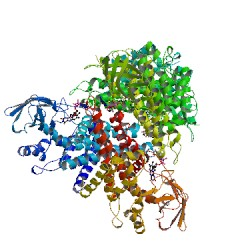Consequences of this mutationA gene holds instructions or the "recipe" to
create a protein.
Different kind of proteins exist: antibodies, enzymes (used to carry out the chemical processes in the body, such as fatty acid oxidation), messengers, structural components and transport or storage proteins. The process to create a protein happens in 2 steps. The first step is called transcription and copies the information stored in a gene's DNA into a similar molecule called RNA. Ribosomes then read the information in this RNA and use it to create proteins. This process is known as translation; i.e., the ribosome "translates" the genetic information from RNA into proteins. A protein is a long chain of specific building blocks called amino acids. The MCAD enzyme consists of 421 of those amino acids in a very specific order. Some of these amino acids attract each other, others repell each other.
The protein made from the information on the ACADM gene is an enzyme. It is used in the fat metabolism (see also the pages on fat metabolism). If there is a mutation in the DNA of a gene (for example an A is replaced by a G) then this means that also the protein that is made based on this DNA will contain an error. In case of the A985G mutation on the ACADM gene the produced enzyme will contain the so called K304E mutation. This means that in the enzyme on position 304 the amino acid K is replaced by an amino acid E, and that the enzyme does not correctly fold. Many different mutations on the ACADM gene have been identified and cause MCAD deficiency. For most of these mutations the result is that the MCAD enzyme will not correctly fold and thus not correctly work. For some of these mutations the result is that the creation of the MCAD enzyme is prematurely stopped, causing the enzyme to be too short and not properly functioning. Most of the mutated MCAD enzymes are also more thermosensitive than the normal (or "wild type") MCAD enzyme. This means that they will more quickly break down if the surrounding temperature rizes. In case the temperature increases, the enzyme will (partially) unfold and will lose its three dimensional structure. While a normal MCAD enzyme will not breakdown below a temperature of 44,5 °C, there are mutated enzymes that already break down at a temperature of not even 40 °C. Read futher about how the diagnosis for MCAD deficiency can be made >
|
||||
|
|
This page was last modified on 26 February 2011 | |||
